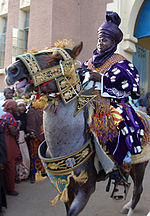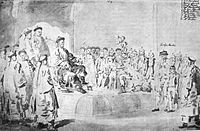- Court (royal)
-
"Royal court" redirects here. For other uses, see Royal court (disambiguation).
- For alternative meanings of the word "court", see: Court (disambiguation).
The court of a monarch, or at some periods an important nobleman, is a term for the extended household and all those who regularly attended on the ruler or central figure. In the largest courts many thousands of individuals comprised the court, many officials or servants in the permanent employ of the ruler, and others attending in hope of political or financial gain, or merely for the society and entertainments offered. As well as being the centre of political life, courts were usually the drivers of fashion, and often where literary, musical and artistic trends first developed. Courts are found in all monarchical high cultures, although relatively little is known about Pre-Columbian court life, for example.
Contents
Patronage
A royal household is the highest ranking example of this. A regent or viceroy may hold court during the minority or absence of a hereditary ruler, and even an elected head of state may develop a court-like entourage of unofficial, personally-chosen advisors and "companions". This position may have been first raised to semi-official status in the entourage of Alexander the Great, based on Persian conventions.[1] The French word compagnon, and its English derivation "companion", literally connotes a "sharer of the bread" at table, and indeed the court is an extension of the great individual's household; wherever members of the household and bureaucrats of the administration overlap in personnel, it is sensible to speak of a "court", whether in Achaemenid Persia, Ming China, Norman Sicily, the Papacy before 1870 (see Curia) or the Austro-Hungarian Empire. A group of individuals dependent on the patronage of a great man, classically in ancient Rome, forms part of the system of "clientage" that is discussed under vassal.
Court culture
Individual rulers differed greatly in tastes and interests, as well as in political skills and in constitutional situations. Accordingly, some founded elaborate courts based on new palaces, only to have their successors retreat to remote castles or to practical administrative centers. Personal retreats might arise far away from official court centres.
Etiquette and hierarchy flourish in highly-structured court settings and may leave conservative traces over generations.
History
East Asia
The courts of Chinese Emperors were among the largest and most complex of all, with the Manchu dynasty occupying the whole Forbidden City and other parts of Beijing. In the late first millennium, the Japanese developed an exquisitely refined court that played an extremely important role in their culture.
Medieval Europe
After the collapse of the Roman Empire in the West, a true court culture can be recognized in the entourage of the Ostrogoth Theodoric the Great and in the court of Charlemagne. In the Roman East, a brilliant court continued to surround the Byzantine emperors.
In Western Europe, consolidation of power of local magnates and of kings in fixed administrative centres from the mid-13th century led to the creation of a distinct court culture that was the centre of intellectual and artistic patronage rivalling the abbots and bishops, in addition to its role as the apex of a rudimentary political bureaucracy that rivalled the courts of counts and dukes. The dynamics of hierarchy welded the court cultures together.
Local courts proliferated in the splintered polities of medieval Europe and remained in early modern times in Germany and in Italy. Such courts became known for intrigue and power politics; some also gained prominence as centres and collective patrons of art and culture. In medieval Spain (Castile), provincial courts were created. Minor noblemen and burguesie allied to create a system to oppose the monarchy on many policy issues. They were called "las Cortes de Castilla". These courts are the root of the current Spanish congress and senate.
As political executive functions generally moved to more democratic bases, noble courts have seen their function reduced once more to that of a noble household, concentrating on personal service to the household head, ceremonial and perhaps some residual politico-advisory functions. If republican zeal has banished an area's erstwhile ruling nobility, courts may survive in exile.
Africa
 A member of court of the Emir of Kano parading on horseback outside the Gidan Rumfa at the annual Durbar festival. Nigeria, West Africa.
A member of court of the Emir of Kano parading on horseback outside the Gidan Rumfa at the annual Durbar festival. Nigeria, West Africa. Main article: Sahelian kingdoms
Main article: Sahelian kingdomsThe kingship system has been an integral part of the more centralized African societies for millenia. This is especially true in West African sahel, where royal courts have been in existence since the 9th century Takrur and Ghana empires. The ruler of the 13th century Mali empire, Mansa Musa, brought a large number of his court with him on the Islamic Hajj pilgrimage to Mecca. Today, the courts of the Ashanti in modern Ghana, the Mande in Mali, the Bamum of Cameroon, the Kanem of Chad, and the Hausa emirs of northern Nigeria continue the pageantry and court lifestyle traditions once common to the region.
Caliphate courts
In the Islamic world, royal courts have played a major role in dynasties from Spain to India. All four major Caliphates had sophisticated courts; this enabled Cordoba, Cairo and Baghdad (the seats of Umayyad, Fatamids and Abbasids) to become the largest, most culturally developed cities of their time. This drew talented people from all walks of life—such as musicians, singers, poets and scientists—to seek employment under the patronage of elite bureaucrats, emirs and Sultans at court. The other Caliphate was the Ottoman, which employed its court's culture to stabilize an empire inhabited by huge non-Islamic populations spanning three continents. Everything from Algeria to the Balkans to Yemen was controlled by the court in Istanbul.
One might expect the caliphates of a leading Islamic world to have courts, but so did many other regional empires such as the Mughals of India and even their ancestors the Timurids of Central Asia, the Shahs of Safavid Persia and The Samanids of Central Asia.
The royal courts in the Islamic world were mostly run by rulers, but there were the exceptions of important elite families such as Barmakids and Nizams who established their own minor courts, enabling them to encourage arts and improve the empire even if the ruling king was useless. All Islamic courts had two things in common, which is that they helped to stabilise politics and society of the empires but they also harbored great bribery and manipulation.
Court officials
Court officials or office-bearers (one type of courtier) derived their positions and retained their titles from their original duties within the courtly household. With time such duties often became archaic, but titles survived involving the ghosts of arcane duties, generally dating back to the days when a noble household had practical and mundane concerns as well as high politics and culture. Such court appointments each have their own histories. They include:
- Almoner
- Butler
- Chamberlain
- Chancellor
- Chapelmaster
- Chaplain = Arch
- Cofferer
- Confessor
- Constable
- Cup-bearer
- Dapifer
- Doorward
- Falconer
- Gentleman of the Bedchamber
- Gentleman Usher
 "Triboulet", illustration for the theatre play "Le Roi s'amuse" ("The King Takes His Amusement") by Victor Hugo. Gravure by J. A. Beaucé (1818-1875) and Georges Rouget (1781-1869).
"Triboulet", illustration for the theatre play "Le Roi s'amuse" ("The King Takes His Amusement") by Victor Hugo. Gravure by J. A. Beaucé (1818-1875) and Georges Rouget (1781-1869).
- Grand Almoner
- Grand Panetier, Panifer
- Grandmaster
- Grand Master of the Hunt
- Great officers
- Groom of the Stool
- Herald
- Intendant of the civil list
- Jester = fool
- Keeper of the seal
- King of arms
- Knight -/ Earl Marshal
- Lady-in-waiting
- Maid of Honour
- Majordomo
- Master of the Horse
- Master of the Hunt
- Page
- Panter or pantler
- Secretary
- Pursuivant
- Seneschal
- Standard bearer
- Steward
Court seats
One of the criteria of Norbert Elias' concept of a court society is that it existed in space.[2] Because the German word hof, meaning an enclosed courtyard, can apply to a rural farmstead with outbuildings and walls forming the perimeter, it has also been used for the palatial seat where the court was held. Thus hof or "court" can become transferred to the building itself. For example, though the grand residence Hampton Court on the Thames above London has been a palace where Thomas Wolsey held court as Catholic cardinal (built after the Italian ideal for a cardinal's palace) until his fall and its confiscation by Henry VIII and where William and Mary held court, 1689–94—and though it is built round two main courts—the structure itself, however, is no longer the seat of a court in the sense of this article.
As an example, ambassadors to the United Kingdom are still accredited to the Court of St. James's, and courtiers of the monarchy still have offices in St James' Palace, London. The present monarch, however, holds court at Buckingham Palace, where dignitaries are received.
Some former seats of power (see official residence):
- Castile, medieval Christian province in central current Spain
- Alhambra in Granada, seat of the last Muslim dynasty in current Spain
- The Forbidden City, imperial palace complex walled off from Beijing
- Wawel Castle (Kraków) and Warsaw's Royal Castle (Poland)
- Château de Versailles near Paris in France
- Sanssouci in Potsdam near Berlin
- The Vatican in the Papal States
- Urbino, seat of a duchy in the Marche
- The Red Fort, palatial fortress of the Mughal emperors in Delhi, India
See also
- Aliénor de Poitiers who documented the etiquette of the Burgundian Court in the late 15th century.
- Curia regis
- Masque
- Courtesy book
Notes
References
- Elias, Norbert (1983) [1969]. The Court Society [Die höfische Gesellschaft]. trans. Edmund Jephcott. Oxford.. On the sociology of the court, originally completed in 1939.
- Fox, Robin Lane (1973). Alexander the Great.
Further reading
- Adamson, John (ed.). The Princely Courts of Europe, 1500–1750. Ritual, Politics and Culture under the Ancien Regime, 1500-1750. London, 1999.
- Birke, A., and R. Asch (eds.). Courts, Patronage and the Nobility at the Beginning of the Modern Period, 1450–1650. 1991.
- Burke, Peter. The Fabrication of Louis XIV. New Haven and London, 1992.
- Charles-Edwards, T.M. et al. The Welsh king and his court. Cardiff, 2000.
- Dickens, A.G. (ed.). The Courts of Europe: Politics, Patronage and Royalty, 1400–1800. 1977. Emphasis on patronage.
- Duindam, Jeroen. Myths of Power: Norbert Elias and the Early Modern European Court. Amsterdam, 1995. Critique of Elias. English translation of dissertation Macht en Mythe (1992).
- Duindam, Jeroen. Vienna and Versailles. The courts of Europe’s Dynastic Rivals 1550-1780. Cambridge, 2003.
- Jaeger, C.S. The Origins of Courtliness: Civilizing Trends and the Formation of Courtly Ideals 939–1210. Philadelphia, PA, 1985.
Antiquity
- Spawforth, A.J.S. (ed.). The Court and Court Society in Ancient Monarchies. Cambridge, 2007
Early Middle Ages
- Cubitt, C. (ed.). Court Culture in the Early Middle Ages. The Proceedings of the First Alcuin Conference. Turnhout, 2002
- Hen, Yitzhak. Roman Barbarians: The Royal Court and Culture in the Early Medieval West. Basingstoke: Palgrave Macmillan, 2007. ISBN 978-0-333-78665-9.
- Jones, S.R., R. Marks and A. J. Minnis (eds.). Courts and Regions in Medieval Europe. York, 2000.
- Jong, M. de and F. Theuws (eds.). Topographies of Power in the Early Middle Ages. Leiden, 2001
External links
- Courtstudies.org, The Society for Court Studies, offering a bibliography on court history
- Oxford University bibliography of Early Modern courts 1580–1700, structure and patronage, 2002
- "Court culture: representations of intimacy": division between Hall and Chamber in late medieval noble and royal households
Categories:- Royal and noble courts
Wikimedia Foundation. 2010.


